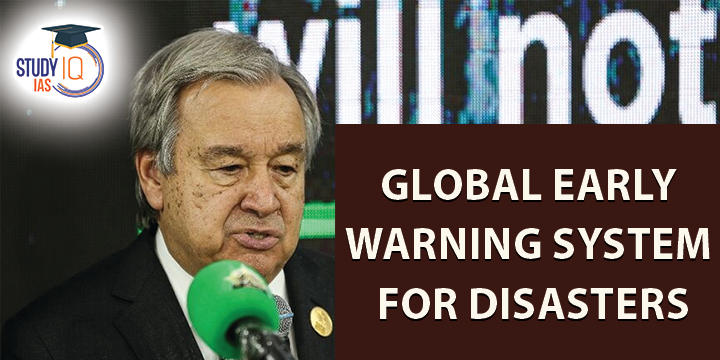Table of Contents
Global Warning System News
- Budget: The five-year plan will cost $3.1 billion, or less than 50 cents per person. This move will protect thousands of lives, especially the most vulnerable ones.
- Status of warning systems: Despite the rise in climate-induced extreme weather events, half the world’s countries lack advanced early warning systems that can save lives.
- Success: The number of people affected by disasters has nearly doubled over the last two decades, but the fatalities have fallen by half.
- A report by Global Commission on Adaptation found that spending just $800 million on such systems in developing countries would cut losses of $3 billion to $16 billion per year.
- Significance: The initiative aims to fill gaps in understanding disaster risk, monitoring and forecasting, rapid communication, and preparedness and response.
- Countries with inadequate infrastructure witness, on average, eight times greater mortality from disasters than those with strong measures in place.
What are Early Global Warning Systems for Disaster
- Early warning systems are an integrated system of hazard monitoring, forecasting and prediction, disaster risk assessment, communication and preparedness activities systems and processes that allows individuals, communities, governments, businesses and others to take timely measures to reduce disaster risks in advance of hazardous events.
- Increasing multi-hazard early warning systems and disaster risk information is one of seven global targets provided by The Sendai Framework for Disaster Risk Reduction 2015-2030.
Levels of Global Warning Systems

Types Of Global Warning Systems
- Based on type of hazard:
- Geological hazards (Tsunamis, earthquakes, landslides)
- Hydrometeorological hazards (cyclones, floods, droughts, cold and heat-waves)
- Biological hazards (locust outbreaks and harmful algae blooms)
- Forest fires
- Health hazards (vector diseases, viral outbreaks)
- Crops and animal disease hazards (lumpy skin disease)
- Based on level of operation:
- Community or people-centred early warning systems: They are operated at a more local level by a municipal government or a community.
- National early warning systems: They are operated by national-level government agencies like a meteorological department.
- Regional systems operated: They are operated at more regional level. Ex: Famine Early Warning System Network (FEWSNET) operated by the United States of America.
- Global systems operated: They are operated at the international level by international organizations like the WHO and FAO.
- Based on detection capability:
- Single-hazard: These are community-operated systems that address only one type of hazard.
- Multi-hazard: They are operated by government departments or ministries to address a variety of hazards or cascading hazards.
Sendai Framework for Disaster Risk Reduction
- The Sendai Framework for Disaster Risk Reduction 2015-2030 was the first major agreement that provides Member States with concrete steps to protect development gains from the risk of disaster.
- It is the successor agreement to the Hyogo Framework for Action (2005–2015).
- The framework recognises that the State has the primary role in disaster risk reduction but that responsibility should be shared with other stakeholders including local government, the private sector and other stakeholders.
- Priorities:
- Understanding disaster risk;
- Strengthening governance in disaster risk to manage disaster risk challenges;
- Investing in reducing disaster risk for resilience;
- Improving disaster preparedness for effective response and to “Building Back Better” in recovery, rehabilitation and reconstruction.

Global Warning Systems in India
Indian Tsunami Early Warning System:
- The Early Warning Centre obtains real-time Seismic data from the national seismic network of the Indian Meteorological Department (IMD) and other global seismic networks.
- The system detects all earthquake events above 6 Magnitude taking place in the Indian Ocean in the less than 12 minutes of its occurrence.
Flash Flood Guidance system:
- IMD has collaborated with the US National Weather Service to develop a Flash Flood Guidance System (FFGS) for the South Asian region.
- FFGS has capability to provide warnings about 6-24 hours in advance for South Asian countries, including India, Nepal, Bhutan, Bangladesh and Sri Lanka, covering most of the Himalayan region.
- FFGS allows all the member countries to provide impact-based flash flood forecasts at the watershed and also at the city level.
























 WhatsApp
WhatsApp